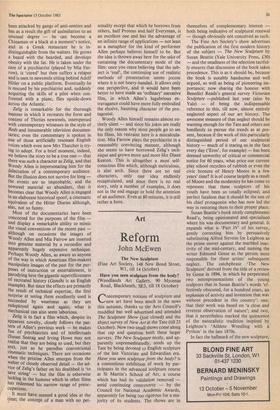Cinema
Underneath the archness
Peter Ackroyd
Zelig (PG', selected cinemas)
The film begins, as all good documentaries should, with a ticker- tape parade in New York in the late Twen- ties: for a brief period, that city is transformed into one of those paperweights which, when shaken, are filled with false snow. And then a number of contemporary personages appear On the screen — Susan Sontag, Saul Bellow and Irving Howe, who between them comprise a fair cross-section of the American 'intellectual' world. They are all discussing someone called Leonard Zelig — 'certainly it is a very bizarre story,' Mr Bellow explains (he did not win the Nobel Prize for such directness).
The fact that this film is written and directed by Woody Allen, who also plays the central role, is enough to make certain members of the audience roar with laughter for no particular reason (a phenomenon one also observes among critics), although it becomes increasingly difficult to see why. The eponymous hero is an 'Incredible Changing Man', a human chameleon who adopts the appearance and characteristics of whomever he is with. As a boy he had
been attacked by gangs of anti-semites and has as a result the gift of assimilation to an unusual degree — he can become a Chinaman or a black at a moment's notice, and in a Greek restaurant he is in- distinguishable from the waiters. He grows a beard with • the bearded, and develops obesity with the fat. He is taken under the care of a psychiatrist (played by Mia Far- row), is 'cured' but then suffers a relapse and is seen in newsreels sitting behind Adolf Hitler on a public platform. Eventually he is rescued by his psychiatrist and, suddenly acquiring the skills of a pilot when con- fronted with a plane, flies upside-down across the Atlantic.
Zelig is remarkable for the thorough manner in which it recreates the form and content of Thirties newsreels, interspersed With contemporary witnesses in the style of Reds and innumerable television documen- taries; even the commentary is spoken in one of those artificially resonant English voices which even now Mrs Thatcher is try- ing to adopt. For a brief moment, indeed, we believe the story to be a true one — that there was such a character as Zelig, and that Woody Allen is impersonating him for the delectation of a contemporary audience. But the illusion does not survive for long — the events are so improbable, and the newsreel material so abundant, that it becomes clear that Woody Allen is engaged In an elaborate historical spoof, a cinematic equivalent of the Hitler Diaries although, alas, not so funny.
Most of the documentaries have been concocted for the purposes of the film — and display a remarkable ability to mimic the visual conventions of the recent past — although on occasions the images of Woody Allen and Mia Farrow are inserted Into genuine material by a recondite and apparently hugely expensive technique. Perhaps Woody Allen, as aware as anyone of the way in which American film-makers manipulate images of the past for the pur- poses of instruction or entertainment, is Parodying here the gigantic superciliousness of recreated history (Gandhi is an English example). But since the effects are primarily the result of technical expertise, the first surprise at seeing them excellently used is succeeded by weariness as they are redeployed again and again; what is mechanical can also seem laborious.
Zelig is in fact a film which, despite its apparent novelty, closely follows the pat- tern of Allen's previous work — he makes fun of psychiatrists and of intellectuals (Susan Sontag and Irving Howe may not realise that they are being so used, but they are), just as he parodies conventional cinematic techniques. There are occasions when the pristine Allen emerges from the welter of closely observed detail — the ad- vice of Zelig's father on his deathbed is 'to save. string' — but the film is otherwise lacking in the humour which in other films has redeemed his narrow range of preoc- cupations.
. It must have seemed a good idea at the Lime; the concept of a man with no per-
sonality except that which he borrows from others, half Proteus and half Everyman, is an excellent one and has the advantage of an infinite range of applications — not least as a metaphor for the kind of performer Allen perhaps believes himself to be. But the idea is thrown away here for the sake of sustaining the documentary mode of the film: once you cease believing that the sub- ject is 'real', the continuing use of realistic methods of presentation seems jocose where it is not heavy-handed. It allows only one perspective, and it would have been better to have made an 'ordinary' narrative film, in which Allen's lugubrious ex- travagance could have more fully embodied the elusive, haunting character of the pro- tagonist.
Woody Allen himself remains almost en- tirely silent — and since his jokes are really the only reason why most people go to see his films, his restraint here is a miscalcula- tion. Mia Farrow plays the psychiatrist in a reasonably convincing manner, although she seems to have borrowed Zelig's tech- nique and grown more and more like Diane Keaton. This is altogether a most self- conscious film which, although meticulous, is also arch. Since there are no real characters, only one idea endlessly recapitulated, and since there is no real story, only a number of examples, it does not in the end engage or hold the attention of an audience. Even at 80 minutes, it is still rather a bore.











































 Previous page
Previous page